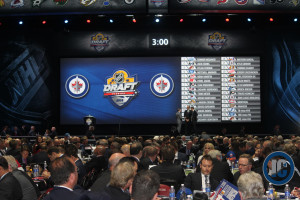
As we await tonight’s NHL Draft Lottery, here is a look at some of the history of the NHL Draft, and the major changes in determining draft order.
Origins of the NHL Draft
The first NHL Draft was held on June 5, 1963 in Montreal. At the time, it was called the “NHL Amateur Draft”, as the only players eligible were 18-20 year-olds from non-professional leagues. The name was changed to the current moniker in 1980 – the “NHL Entry Draft” – as professionals (from age 18-20) from the defunct WHA entered the league via the draft. (With the famous exception of Wayne Gretzky, who came to the NHL undrafted). From 1963 until 1994, draft order was determined in reverse order of the standings; the team finishing last got the first pick, and vice-versa. In some cases, the way picks were awarded led to allegations of “draft fixing”, most notoriously, the 1984 Pittsburgh Penguins, who may have purposely tanked in order to draft phenom Mario Lemieux. (While controversial, the Pens franchise later flourished, winning back-to-back cups in ’91 & ’92).
Another famous story which showed the potential loopholes of the draft system involves revered Montreal Canadiens GM Sam Pollock. Back in 1971, Guy Lafleur was the best prospect available in the draft – in fact, he might have been the most coveted prospect to that point in *draft history. Seeing an easy mark, Pollock made an offer to the poorly run California Golden Seals, who were sitting in last place overall, and quite likely to stay there. In exchange for the Seals’ first round pick, Pollock gave up Montreal’s first round pick, last year’s first round draft choice, another prospect, and cash. Though Pollock now held what looked like the top pick in 1971, the Los Angeles Kings actually began to threaten the Seals for last overall in the NHL. Pollock – who was set on “earning” that first overall pick – made yet another crafty move, sending veteran centre Ralph Backstrom to Los Angeles in order to make sure they finished above the Seals. It worked, and the Canadiens drafted Lafleur, a future Hall of Famer, and the dominant forward on their 5 cup winning teams.
*Given that the draft began in 1963, you would be right to ask “what about Bobby Orr?” Well as it turns out, Bobby Orr did not join the NHL via the draft either – his rights were locked up by the Boston Bruins in 1962, who sponsored Orr’s junior team and signed the precocious youngster when he was just 14 years of age
The NHL Draft Lottery Begins
The NHL changed the way that the draft selections were awarded in 1995. They decided that all non-playoff teams would be entered in a lottery, whereby the winner would move up by as many as 4 picks. The odds of winning the lottery were heavily weighted towards the teams which finished lower in the standings; for instance, in the most recent draft run under these rules (2012), the odds of the last place team getting the first-overall pick was 48.3%, and the last place team could fall no lower than the second-overall pick. Because the winning team could only move up by 4 picks, the teams which finished bottom-5 in the standings were referred to as “lottery picks”, as only those five teams had a chance to move up to pick fist-overall. The lottery system was a huge win for the Chicago Blackhawks in 2007, as they finished 26th overall and were slated to pick fifth that year. Instead, the Hawks won the lottery, and took superstar Patrick Kane first overall. While it was more typical for the lowest-finishing teams to win the lottery, in 2011, the New Jersey Devils were slated to pick 8th, but won the lottery and moved up to pick 4th. (They drafted defenceman Adam Larsson, of Taylor Hall trade fame).
NHL Draft Lottery Modified
In 2013, the NHL changed the formula for the NHL draft lottery. Rather than the lottery winner moving up 4 draft spots, the winner would move all the way up to #1. As before, only non-playoff teams were eligible to participate in the lottery. This particular system was run for three years, and interestingly, the lottery winner never came from the last place team – in 2013, Colorado (2nd last) bested Florida (last); in 2014, Florida (2nd last), took the pick from Buffalo (last); and in 2015 – the McDavid draft – the Oilers finished 28th (3rd last), and won the lottery over Buffalo (last), and Arizona (2nd last).
Beginning in 2016, the lottery format changed again. Rather than simply holding a lottery for the first overall pick, the top-3 picks all were drawn through the lottery. Last season, the Toronto Maple Leafs finished last, followed by the Edmonton Oilers and the Vancouver Canucks. However, the lottery picks were won by Columbus (4th best odds, won 3rd pick), Toronto (best odds, won 1st), and of course, the Winnipeg Jets, who had the 6th best odds, but won the second overall pick which became superstar sniper Patrik Laine.
The overall format in 2017 remains the same, but there’s a major tweak, as the expansion Las Vegas Golden Knights enter the fray. The Knights will have the same draft odds as the team which finished in 28th place – Arizona. The chart below shows the statistical likelihood of where each team will draft in 2017:

Since only the top three spots are up for grabs, no team can fall more than 3 spots from their “natural” draft spot, i.e., the spot they would have were there no lottery. Overall, the new lottery system is far less rewarding to the lowest-finishing teams – in the old system, the last-place team had almost a 50% chance of getting the first pick, and a 100% chance of picking in the top-2! Concurrently, the odds are significantly improved for the higher finishing lottery teams compared to the original system from 1995. You can be sure that if the NHL continues to draft this way for the next decade, at some point a team finishing way down in the double-digits (10-15), will climb up and win one of those three “lottery” spots, to everyone’s great surprise. Whether that happens this year or not remains to be seen.


